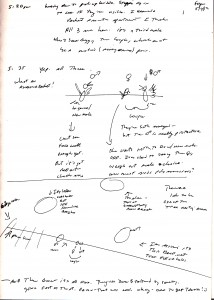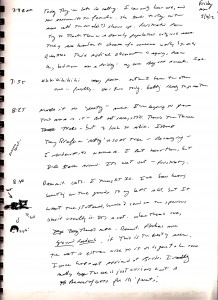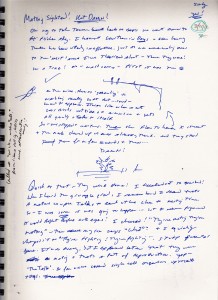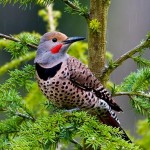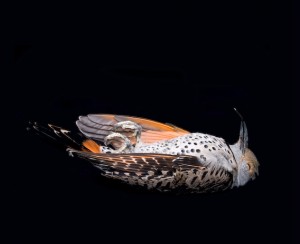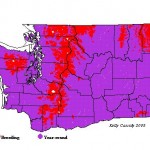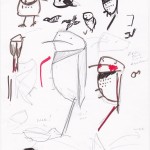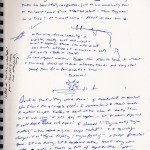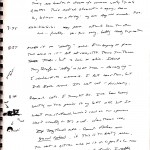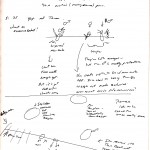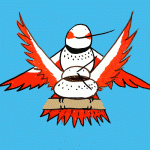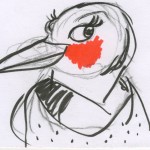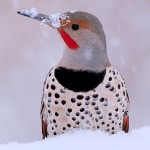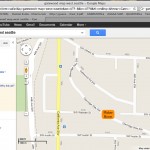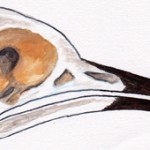Colpates auratus (cafer)
Animalia
Chordata
Vertebrata
Aves
Piciformes
Picidae
Picinae
Colaptes auratus – named by Linnaeus in 1758
Colpates auratus cafer – named by Gmelin in 1788
Introduction
In West Seattle, we have a plethora of interesting birds, many of which I’m already familiar with. The flickers came as a surprise – it was a call I didn’t recognize, then a figure, then a whole animal. As my fondness grew for them, my frustration at how they are treated as pests, even placed into a caste system of least favourable by observers and neighbors. As the weeks drew down and the pair mated, they were either moved or cast out by property owners. I still hear them, but sadly no brood has been seen after mating.
Here is an account of a citizen’s actions towards a flicker in the area from 2008.
Observation Area
The spot to observe was serendipitously chosen by my six-year-old son. We have a trail we walk down each week on our way to a family obligation. We were talking about animals I could cover – tarantula, sea horse, spitting cobra; all his favourites I sadly had to explain why I turned them down, which was proximity and convenience. (I would have LOVED to observe a spitting cobra!) Then we noticed the flickers. He began asking what the bird that was calling at that moment was, and said I didn’t know. Then I saw it and recognized the bib and spots. Somewhere in my pre-teen years I practically memorized the Peterson’s Guide to Eastern Birds, and identified it as a flicker. Only, it was red, not yellow-winged. I knew it was the right fit, so I agreed to observe those and we both left happy.
In the mornings not at school and before work I would venture down to the spot. Having now recognized the call from some audio recordings and beginning to find them on the internet, I could tell they were the birds waking up at around 7:30 am and winding down around 4:30pm. Seeing them over the weeks became increasingly impossible. Getting permission to have more direct observation of their roost was nil, and while some neighbors liked them, many did not and were aggressively trying to dissuade the flickers from roosting. In the end, we can still hear them, but not as much, and the breeding roost has appeared empty.
Here are a set of observational notes from Week 3 and Week 5:
Cultural
Flickers, themselves, aren’t a huge part of folklore. If you look up woodpecker, though, there’s plenty. I wanted to find at least one and that’s pretty much as far as it got. Funny thing is, it’s a pertinent part of Lenape history, indigenous to the area near which I was born.
Later, I found this stamp: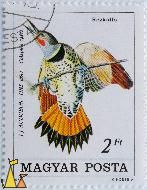 My father is Hungarian and we are Maygar, so I was very excited to see this and discover there was a deeper connection to this type of flicker.
My father is Hungarian and we are Maygar, so I was very excited to see this and discover there was a deeper connection to this type of flicker.
Natural History
The following are photos of this particular subspecies:
Red-shafted flickers have a gray face, brown head (crown), with red cheeks, or mustache, on the males. Yellow-shafted forms have tan faces and gray crowns, and a red crescent on the nape. Males have a black mustache stripe.
It’s the flight-feather and tail shafts that determine East (yellow – covering Texas and the Great Plains) from West (red – rest of the Continental West) – but there is a bit of hybridization taxonomists are working to separate out. They believe it’s in the mtDNA where the key lies in the alleles that differentiates colour, even when direct cross-breeding is rare.
Unique Observation: Anting
Surprisingly, ants – or ant larvae – make up approximately 45% of the flicker’s diet. They also eat berries, fruits, seeds and nuts, but insects are where it’s at. Since ants burrow underground, flickers forage on the ground, and may be flushed out of brushy areas by accident if you’re walking about in a clear patch by the edge of the woods.
Spoken Word
Stiff
I. Pure Animal
You freeze
Hold pose
Make no contact with the younger man
Letting him know she’s your mate, not his.
It’s your nest, not his.
It’s your tree, not his.
Heads bob, at first it looks like
The swaying bough is moving them.
Heads bob harder and then comes the
Rhythm call woikawoikawoikawoikawoika
Get the to a nunnery, boy-o.
II. Relative
A pair of stiff males
suits on a sidewalk
Caught off guard one got the job
The other didn’t.
Still. You both keep still.
You have her underwear in your suitcase
A gift. He looks at you. Through you, he walks.
He nods, the gentleman’s nod of good day to you.
Yet, you’re a slug.
She’s not your mate, but his.
It’s not your nest, it’s his.
It’s not your tree he will push you from. Soon.
III. Abyss
I reeked of craving.
Isolated, enchambered, no breath.
Seven years a boot on my neck, a cuckold, watching
The tan line move in and out of other rings.
Yet he wore the cinnamon patch, stitched glyph, almost proudly.
Writhing, I did my best to not damage the roost.
In Yiddish I avoided what is cursed under breath,
Gai kakhen afenyam, as we are warned, “Don’t.”
But for a day, I broke.
Once, like him, I was the Red Wing of my marsh.
When I was exhausted from that life, I begged for the
Singleness of purpose of Flicker mates, never seeking unless
One passes on, and even then, not often.
The widow-watcher looks at me from the empty cup
Encased in the peat-smelling, rotting twist only seven feet above me.
There is no space.
We are both one half of a lost pair.
Around me, he calls weetaweetaweeta as if his brood were still there
From the years before, as if she was still there
From the years before, as if their tree was still there –
Now it’s just a tree with a hole in it.
He looks at me as I watch him.
He looks, I watch, then we switch
Over and over
Me trying to figure out if he’ll flutter and fly if I get closer.
He trying to figure out if I can fit in the tree.
Athena Nation
Animal Others – Spring Swallows
4/30/12
IMAGES!
- Ceci n’est pas une flicker.



